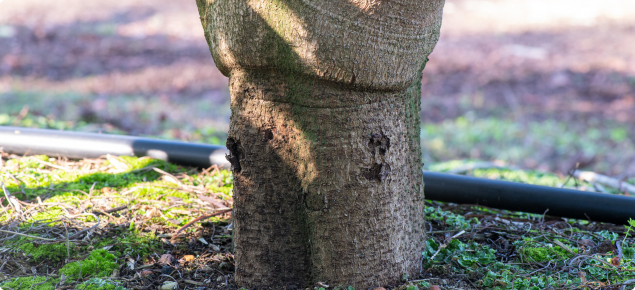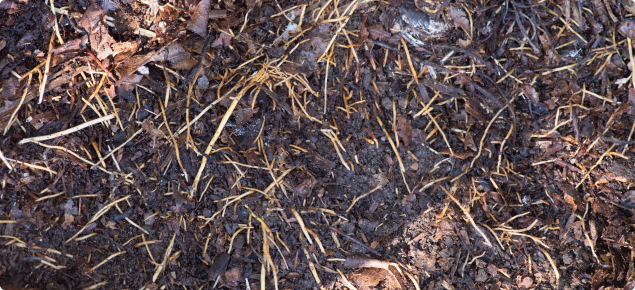Phytophthora cinnamomi is a soil-borne water mold that is believed to have originated from South East Asia and has now spread to over 70 countries. Avocado trees did not evolve in conjunction with root and so have no natural defences to it. When root rot first began appearing in avocado orchards in California from 1940 onwards, there were no control methods available, resulting in mass orchard deaths. Now, an integrated method of control has been developed and perfected for use in the production of avocados; it is called the Pegg Wheel, after its inventor Ken Pegg.
The Pegg Wheel is an integrated management system for controlling Phytophthora root rot in avocado orchards. It consists of six sections which when applied collectively represent the current best methods for managing phytophthora root rot in avocado orchards.
Site selection
The initial selection of the site to be used is the most critical part of the Pegg Wheel. Broadly, selection can be focused on whether the site receives large volumes of water at one time; sites in cyclonic areas are therefore not ideal as even the most well drained soil can be saturated by very large precipitation events. Additionally there are other aspects of rainfall to be taken into account:
- Is there enough rainfall to fulfil irrigation requirements?
- Is the water you have legally available - is a license required?
- Is the site susceptible to frost which can cause unnecessary stress?
Good well drained soil is required to prevent waterlogging. If the clay content is higher, for example above 15%, then the creation of planting mounds can improve tree survival and performance. Soil depth is important too. Shallow soils with heavy clay subsoils or similar are not suitable for avocado production, and mounding may increase the soil depth enough to make the ground suitable to production.
Avoid areas with very high clay content, rocky hardpan and small seasonal soaks. If these areas are planted it is likely that phytophthora root rot will become a management concern in those locations. It may be more appropriate to reduce the risk of phytophthora establishment by avoiding those areas entirely rather than trying to manage the disease later with chemical control and by staghorning and removing affected trees.
The bulk density of the soil is important too. Further advice may be sought with an agronomist.
Rootstock selection
There is a large range of rootstocks available for growing avocados commercially, however their ability to resist attack from phytophthora root rot can vary considerably. Research has shown that the most resistant rootstocks used in Australia are Velvick, Dusa, SHSR-4, and SHSR-02, all of which are currently very difficult to obtain. Other common rootstocks such as Reed and Zutano have very poor resistance to phytophthora attack.
Further, the compatibility of rootstock and scion is very important. For example the Zutano rootstock can cause ‘benching’ which is where the scion overhangs the rootstock. The larger scion then causes root starvation which leaves the tree more susceptible to root rot in years when the crop load is high and the tree is under high levels of stress.
Other factors to take into account are local conditions as rootstocks handle conditions in different ways. For example in an area with saline water a salt tolerant rootstock such as Nabal may be more useful than a well-known phytophthora root rot resistant one as the entire tree and rootstock will be under less stress from the saline water, and therefore will be better able to cope with the stress caused by the root rot (which will always be there saline water or not).
Irrigation management
Avocados are very sensitive to both waterlogging and lack of water, which causes stress to the roots hence increasing their susceptibility to root rot. Ideally soil moisture should be maintained at a consistent level that is neither too wet nor too dry. The Avocados Australia Best Practice Resource describes what level of soil moisture avocado trees are best kept at. The use of pulse irrigation is recommended in avocado orchards to effectively manage soil moisture.
Chemical control
Treatment with metalaxyl (eg. Ridomil)-can be used at tree planting while older trees can be sprayed with potassium phosphonate to keep the root rot at bay. Trees confirmed to be sick with phytophthora root rot will require injections. These Injections can be done with a 20% solution with the injection sites spaced 10 cm apart around the trunk. Application of this fungicide is best done when roots are actively growing. After application phosphonate will move to the leaves before moving down to the roots after about 10 days. The movement of the phosphonate in the tree is determined by the source-sink relationship within the tree. Therefore if it is applied when the leaves are growing the roots will accumulate less phosphonate than the leaves as the leaves are the greater sink. Therefore application is usually targeted for periods when the last leaf flush has finished and there is a flush of new roots. This is normally around late spring/early summer and late autumn/early winter. However, during the late spring period there is still competition between the leaves and the roots. Therefore all applications should be done during the autumn/winter period when the roots are the dominant sinks for the phosphonate.
To guide the rate of application of phosphonate root testing should be done. The general aim of root testing is to keep the level of phosphite (phosphonate is converted into phosphite in the tree) in the roots above 50 mg/kg. Achieving this usually means attaining a level of up to 150 mg/kg in the roots before winter. This will usually ensure that levels in the tree the following spring, although reduced, will still be above 50 mg/kg threshold.
More information about the management of root phosphite levels can be found on the Avocados Australia Best Practice Resource. Included in this is the name and contact of the root testing laboratory that exclusively does avocado root phosphite testing.
Research currently is aimed at finding additional ways of controlling root rot, which are generally complimentary to the current main practice of using phosphonate sprays. Thus, they will likely not make phosphonate spraying obsolete, and have no reason to as phosphonate sprays are extremely effective and will remain effective for a long time.
The second form of chemical control is the calcium ion Ca2+ which acts as a mild fungicide. There are two main sources of it: from calcium nitrate fertiliser and from applications of gypsum (calcium sulfate dihydrate). Ken Pegg, the creator of the Pegg wheel recommends 20g/m2 of gypsum every two months.
Organic amendments
Mulch is recommended for phytophthora management. The reasons for doing so are two-fold: mulch minimises root stress, and the detritivore organisms that live in mulch release cellulases which destroy the phytophthora root rot organism. Most kinds of mulch are acceptable; woody mulch, straw, compost. The important part about using mulch is to ensure the carbon to nitrogen ratio is suitable to minimise nitrogen drawdown. For example an application of unaged woody mulch to an avocado orchard a few years ago resulted in very sick yellow trees heavily deficient in nitrogen.
Fallen branches and pruning’s are best mulched and placed under the drip line. Mulches to avoid are those that carry the risk of introducing disease. From a WA perspective there is less chance of this, but as an example, in some avocado growing regions abundant peanut straw is avoided by avocado growers as it can carry verticillium wilt into the orchard.
Organic matter is likely more important than most people actually treat it as. Before the development of phosphite treatments in the early 1980’s research in 1974 by Broadbent and Baker found that soils with very high levels of organic matter found in an avocado orchard were very suppressive to phytophthora. The mechanism was the one described above, where detritivores living in the organic matter rich soil directly inhibit the phytophthora organism. When the suppressive soil was steam treated to kill all soil organisms the phytophthora grew uninhibited in the soil, until the soil microorganism recovered after 6 weeks in some of the steam treatments.
For those curious to know how the soil was created but lacking the time to find the research themselves a summary of the process is as follows: for two years before the avocados were planted cover crops were grown and disced in with chicken manure, dolomite (a mixture of calcium carbonate and magnesium carbonate) and superphosphate. The dolomite is similar to gypsum in that it supplies calcium ions. After planting cover crops were grown and cut with the cut material being deposited near to the base of the tree (but not directly up to the trunk). Cover crops of lab lab and maize were grown in the summer and disced in before maturity and lupins were grown in the winter and also disced in before maturity. Chicken manure was applied twice a year at 4.5 tonnes per ha per application. Dolomite was also applied whenever the soil pH went below 6.
Inorganic nutrition
Calcium ions provided through calcium nitrate have a mild antifungal effect. Ammonium ions similarly are deadly to phytophthora root rot, unfortunately they are also toxic to avocado feeder roots so are best avoided on growing orchards. On new orchard land an ammonium ‘wipe-out’ can be created by mixing a fresh manure into the planting area six months before planting. Any manure will do, as long as it is fresh and affordable.




